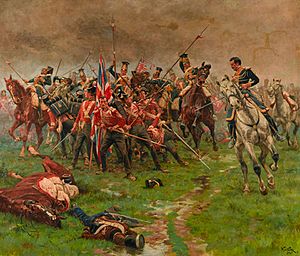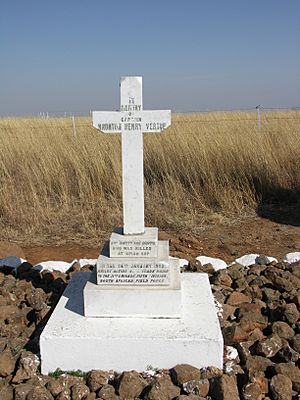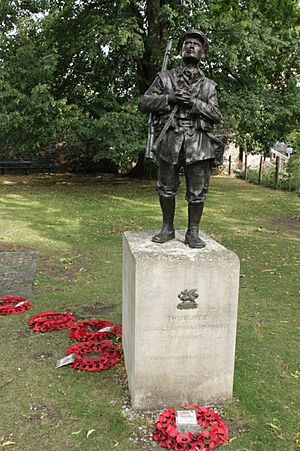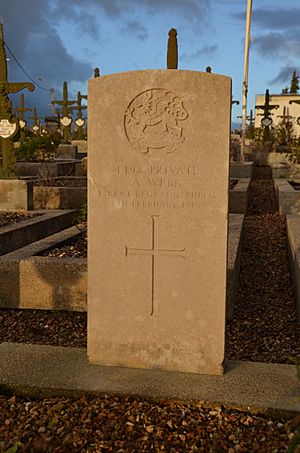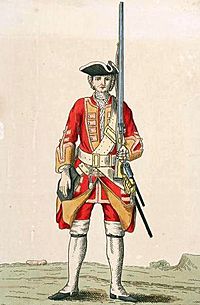Buffs (Royal East Kent Regiment) facts for kids
Quick facts for kids Royal East Kent Regiment ("The Buffs"); 3rd Regiment of Foot |
|
|---|---|
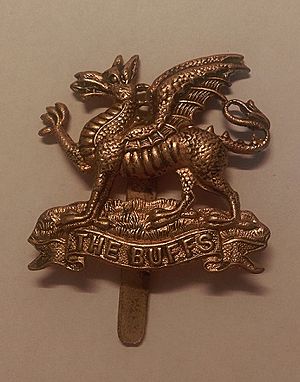
Badge of The Buffs
|
|
| Active | 1572–1961 |
| Country | |
| Branch | |
| Type | Line Infantry |
| Role | Infantry |
| Garrison/HQ | Howe Barracks, Canterbury |
| Nickname(s) | Howard's Buffs The Old Buffs The Resurrectionists |
| Motto(s) | Veteri Frondescit Honore Latin: "Its Ancient Honour Flourishes"; "Its Ancient Honour is Ever-Green" |
| Colors | Buff Facings |
| March | Quick: The Buffs Slow: The Men of Kent |
| Anniversaries | Albuhera Day (16 May). |
| Engagements | Corunna (17 January 1809) Albuhera (16 May 1811) |
| Commanders | |
| Notable commanders |
Colonel Charles Churchill (1689–1707) John Campbell, 2nd Duke of Argyll (1707–1713) Archibald Douglas, 2nd Earl of Forfar (1713–1715) Lieutenant-General Thomas Howard (1737–1749) Colonel Sir George Howard (1749–1763). |
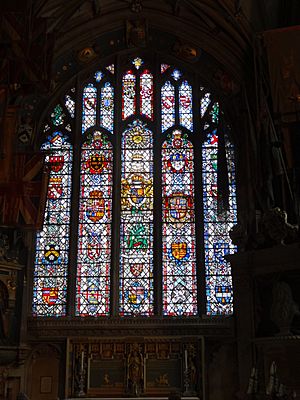
The Buffs (Royal East Kent Regiment) was a famous British Army regiment with a long history. It was also known as the 3rd Regiment of Foot. This group of soldiers was traditionally formed in Kent, England, and based in Canterbury.
The Buffs started way back in 1572, making it one of the oldest regiments in the British Army. It was ranked as the 3rd oldest regiment. Over nearly 400 years, the regiment served with great honor. They earned 116 battle honours, which are special awards for their bravery in battles.
In 1881, the regiment's name changed to the Buffs (East Kent Regiment). Then, in 1935, it became the Buffs (Royal East Kent Regiment). In 1961, the Buffs joined with another regiment to form the Queen's Own Buffs, The Royal Kent Regiment. This new regiment later merged with others in 1966 to create the Queen's Regiment. Finally, in 1992, the Queen's Regiment joined with the Royal Hampshire Regiment to form today's Princess of Wales's Royal Regiment.
Contents
A Look Back: The Buffs' History
How the Regiment Began (1500s-1600s)
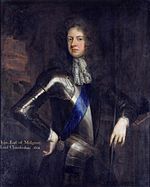
The Buffs started during the Eighty Years' War (1568–1648). This was when the Dutch fought for their freedom from Spain. Many Protestants from across Europe supported the Dutch.
The regiment's beginnings were with Thomas Morgan's Company of Foot. This was a group of 300 volunteers from London, formed in 1572. These English and Scottish volunteers later joined together in 1586. They became part of the Scots Brigade, which served with the Dutch army for many years.
In 1665, the Second Anglo-Dutch War began. Some soldiers from the Brigade refused to swear loyalty to the Dutch leader. Sir George Downing, the English ambassador, used his own money to form a new group called the Holland Regiment. This was made up of the soldiers who had refused to sign.
By 1668, it was known as the 4th (The Holland) Regiment.
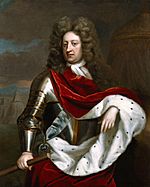
When the Third Anglo-Dutch War started in 1672, more companies were added. After the war ended in 1674, these soldiers joined the Anglo-Scots Dutch Brigade. They fought in the Franco-Dutch War (1672-1678).
In 1688, the regiment came to England with William III of England. It became part of the English army as the "4th The Lord High Admiral's Regiment." In 1689, it was renamed the 3rd (Prince George of Denmark's) Regiment of Foot. During the Nine Years War (1689–1697), they fought in Europe. They took part in battles like Walcourt, Steenkerque, and Landen.
The 1700s: More Wars and Changes
During the War of the Spanish Succession, the regiment fought in famous campaigns led by John Churchill, 1st Duke of Marlborough. They were at the battles of Blenheim, Ramillies, Malplaquet, and Oudenarde.
Until 1751, regiments were often named after their current leader. After Prince George of Denmark died in 1708, the regiment was sometimes called the 'Holland Regiment' or "Buffs". This was because of the buff-colored parts of their uniform. They were also called "The Old Buffs" to tell them apart from another regiment, "The Young Buffs."
For 25 years, the regiment mostly served in England and Scotland. In 1742, they went to Flanders for the War of the Austrian Succession. They fought bravely at the Battle of Dettingen in 1743 and the Battle of Fontenoy in 1745.
When the 1745 Rising began in Scotland, the Buffs were sent there. They fought in the Battle of Falkirk Muir and Battle of Culloden in 1746. After that, they returned to Europe and saw action at the Battle of Lauffeld in 1747.
In 1751, the regiment was officially named the 3rd Regiment of Foot, "The Buffs". The Seven Years' War started in 1756. In 1758, the Buffs went to the West Indies. They helped capture Martinique and Guadeloupe in 1759. After returning home, they helped capture Belle Île in 1761. They then moved to Portugal and fought at the Battle of Valencia de Alcántara in 1762.
Fighting in the Napoleonic Wars
The regiment went to the West Indies in 1795 for the French Revolutionary Wars. They helped capture Grenada in 1796, Saint Vincent in 1796, and Trinidad in 1797. They returned home in 1802.
In 1808, the Buffs went to Portugal for the Peninsular War. This was a major part of the Napoleonic Wars. A part of the regiment fought at the Battle of Corunna in 1809. The rest of the regiment stayed in Portugal. They fought at the Battle of Talavera in 1809 and the Battle of Bussaco in 1810.
They also fought bravely at the Battle of Albuera in 1811 and the Battle of Vitoria in 1813. The Buffs then chased the French army into France. They fought in battles like the Battle of the Pyrenees (1813), Battle of Nivelle (1813), and Battle of the Nive (1813). They also took part in the Battle of Orthez (1814) and the Battle of Toulouse (1814). After the war, they stayed in France as part of the occupation army until 1818.
The Victorian Era and Beyond
From 1821 to 1827, the regiment served in the British colony of New South Wales (Australia). They were divided into different groups across the colonies. In 1827, they moved to Calcutta, India. The Buffs also fought in the Crimean War, taking part in the siege of Sevastopol in 1854.
In 1858, a famous phrase, "Steady, The Buffs!", came from Lieutenant John Cotter of the 2nd Buffs. The 1st Battalion fought in the Second Opium War and the Perak War. The 2nd Battalion saw action in the Anglo-Zulu War.
In 1881, the regiment became the Buffs (East Kent Regiment). They kept their two battalions and added new volunteer battalions.
The 1st Battalion served in the Anglo-Egyptian War and later in India. The 2nd and other battalions fought in the Second Boer War in South Africa. Captain Naunton Henry Vertue of the 2nd Battalion was sadly wounded and died at the Battle of Spion Kop in 1900.
After the Boer War, the 2nd Battalion returned to the UK in 1902. In 1908, the army was reorganized. The Buffs now had one Reserve and two Territorial battalions.
The First World War (1914-1918)
During the First World War, the Buffs grew a lot. Ten more battalions were created to help with the war effort.
Regular Army Battalions
The 1st Battalion went to France in September 1914. The 2nd Battalion returned from India in December 1914 and stayed in England. The 3rd Battalion remained in Canterbury as a training unit.
Territorial Force Battalions
The 1/4th and 1/5th Battalions sailed for India in October 1914. The 1/5th later moved to Mesopotamia. Other battalions (2/4th, 2/5th, 3/4th, 3/5th) stayed in England. The 10th Battalion was formed in Egypt in 1917 and then went to France.
New Army Battalions
The 6th, 7th, 8th, and 9th Battalions were formed for active service in France. Corporal William Richard Cotter was awarded the Victoria Cross for his bravery while serving with the 6th Battalion. After the war, some soldiers from the Buffs also fought in the Third Anglo-Afghan War in 1919.
The Second World War (1939-1945)
The Buffs played a big part in the Second World War.
The 1st Battalion fought in many places, including the North African Campaign and the Italian Campaign. They were involved in tough fighting at the Battle of Anzio. They stayed in Italy until the final offensive in 1945.
The 2nd Battalion went to France in 1940 with the British Expeditionary Force. They fought in the Battle of Dunkirk and were evacuated back to Britain. Later, they went to the Far East and fought in the Burma Campaign.
The 4th Battalion also served in France in 1940. In 1941, they were sent to Malta and helped defend it during the siege. They later took part in the difficult Battle of Leros in 1943.
The 5th Battalion was formed in 1939. They also served in France in 1940 and were evacuated from Dunkirk. In 1942, they joined the 78th Division. They fought in Operation Torch (the Allied landings in North Africa) and the Tunisia Campaign. They were key in capturing Longstop Hill. The 5th Buffs then fought in the Sicilian Campaign and the Italian Campaign until 1945.
Many other Buffs battalions were raised for home defense or training. Some were even converted into armored or artillery units due to army needs.
After the Wars
In 1947, the 4th and 5th Buffs battalions merged. In 1956, another artillery unit was converted to infantry and became the 5th Buffs.
As mentioned earlier, in 1961, the Buffs joined with the Queen's Own Royal West Kent Regiment. They formed the Queen's Own Buffs, The Royal Kent Regiment. This regiment later merged with others in 1966 to become the Queen's Regiment. Finally, in 1992, the Queen's Regiment combined with the Royal Hampshire Regiment to create the Princess of Wales's Royal Regiment.
Regimental Museum
You can still find some exhibits about The Buffs (Royal East Kent Regiment) at Beaney House in Canterbury. Most of their collection moved to the National Army Museum in 2000.
Important Leaders (Colonels-in-Chief)
These were the special leaders of the regiment:
- 1689–1708 Prince George of Denmark (husband of Queen Anne)
- 1906–1914 King Frederick VIII of Denmark
- 1914–1947 King Christian X of Denmark
- 1947–1961 King Frederick IX of Denmark
Brave Soldiers of the Buffs
Many soldiers in the Buffs showed incredible courage. Here are a few examples:
- During the Battle of Albuera in 1811, Ensign Thomas was killed while carrying the Regimental Colour (flag). The flag was captured but later retrieved. Lieutenant Matthew Latham, carrying the King's Colour, was attacked. He tore the flag from its staff and hid it in his jacket. This brave act is remembered with a silver centerpiece called "The Latham Centrepiece" in the regimental museum.
- In the Battle of Taku Forts, Private John Moyse was captured. He was executed for refusing to show disrespect to a local leader. His defiance was made famous in a poem called The Private of the Buffs.
- Sgt Frederick Milne of the 2nd Battalion was part of the small group defending Rorke's Drift in 1879. He survived the battle.
- Colonel Richard S. Hawks Moody was a distinguished officer and historian of the regiment. He fought alongside Winston Churchill in 1897. He later wrote a history of The Buffs from 1914–1919.
- The war artist Ernest Stafford Carlos joined the 8th Battalion in 1916. His sketches and paintings show life on the Western Front. He was killed in action during the Battle of Messines in 1917.
- Private Percy James Fellows, a Lewis gunner in the 10th Battalion, showed great bravery in the Battle of Épehy in 1918. He was mortally wounded while facing the enemy.
- Bernard George Ellis was awarded the Albert Medal in 1918, which was later changed to a George Cross in 1971.
- Captain William Douglas-Home served in the 7th battalion during the Second World War. He was imprisoned for refusing an order he believed would harm many French civilians. After the war, he became a successful playwright.
Freedom of the City of London
The regiment was given the special honor of the Freedom of the City of London. This allowed them to march through the city with pride.
Battle Honours
The Buffs earned many battle honors for their bravery. The ones in bold were proudly displayed on their flags (Colours).
- Earlier Wars:
- Blenheim, Ramillies, Oudenarde, Malplaquet, Dettingen, Guadeloupe 1759, Douro, Talavera, Albuhera, Vittoria, Pyrenees, Nivelle, Nive, Orthes, Toulouse, Peninsula, Punniar, Sevastopol, Taku Forts, South Africa 1879, Chitral, Relief of Kimberley, Paardeberg, South Africa 1900–02
- First World War:
- Aisne 1914, Armentières 1914, Ypres 1915 '17, Gravenstafel, St. Julien, Frezenberg, Bellewaarde, Hooge 1915, Loos, Somme 1916 '18, Albert 1916 '18, Bazentin, Delville Wood, Pozières, Flers-Courcelette, Morval, Thiepval, Le Transloy, Ancre Heights, Ancre 1916 '18, Arras 1917, Scarpe 1917, Messines 1917, Pilckem, Passchendaele, Cambrai 1917 '18, St. Quentin, Avre, Amiens, Bapaume 1918, Hindenburg Line, Épéhy, St. Quentin Canal, Selle, Sambre, France and Flanders 1914–18, Struma, Doiran 1918, Macedonia 1915–18, Gaza, Jerusalem, Tell 'Asur, Palestine 1917–18, Aden, Tigris 1916, Kut al Amara 1917, Baghdad, Mesopotamia 1915–18
- Second World War:
- Defence of Escaut, St. Omer-La Bassée, Withdrawal to Seine, North-West Europe 1940, Sidi Suleiman, Alem Hamza, Alam el Halfa, El Alamein, El Agheila, Advance on Tripoli, Tebaga Gap, El Hamma, Akarit, Djebel Azzag 1943, Robaa Valley, Djebel Bech Chekaoui, Heidous, Medjez Plain, Longstop Hill 1943, North Africa 1941–43, Centuripe, Monte Rivoglia, Sicily 1943, Termoli, Trigno, Sangro, Anzio, Cassino I, Liri Valley, Aquino, Rome, Trasimene Line, Coriano, Monte Spaduro, Senio, Argenta Gap, Italy 1943–45, Leros, Middle East 1943, Malta 1940–42, Shweli, Myitson, Burma 1945
Victoria Cross Winners
The Victoria Cross is the highest award for bravery in the British military. These members of the Buffs received it:
- Major Frederick Francis Maude, Crimean War
- Private John Connors, Crimean War
- Corporal James Smith, First Mohmand Campaign
- Lance Corporal William Richard Cotter, World War I
Uniform and Look
In 1667, the Holland Regiment wore "red jackets lined with yellow." Later, in 1684, they had "red coats, lined with a flesh colour." This started their long connection with buff facings, which is a dull yellow color. In 1685, a notice first used the word "buff" to describe their uniform lining.
By 1707, the regiment had a special symbol: a dragon on a buff background. This was given to them for their "gallant conduct." The dragon was believed to be from the royal arms of Elizabeth I of England, who helped start the regiment in 1572. The dragon and the buff facings (on cuffs, lapels, and linings) became unique to the Buffs. In 1751, they were the only infantry regiment officially named after their uniform color. The green dragon was their "ancient badge."
In 1881, when regiments were reorganized, the Buffs (East Kent Regiment) lost their buff facings. They had to use white collars and cuffs like other English regiments. The dragon stayed on their cap badge, but the white horse of Kent appeared on their collars. The horse was the symbol of the East Kent Militia, which became the 3rd battalion.
The regiment didn't like these changes. In 1887, they were allowed to change their white facings back to buff, even paying for it themselves! By 1890, buff was officially back as their regimental color. In 1894, the dragon was also allowed back as their collar badge.
Until the regiment merged, the dragon badge and buff facings remained their main distinguishing features. Even on their simpler dark blue uniforms after World War II, the buff color was still seen as piping on their shoulder straps.
Alliances
 Canada – The Queen's Own Rifles of Canada (1914–1961)
Canada – The Queen's Own Rifles of Canada (1914–1961)
See also


